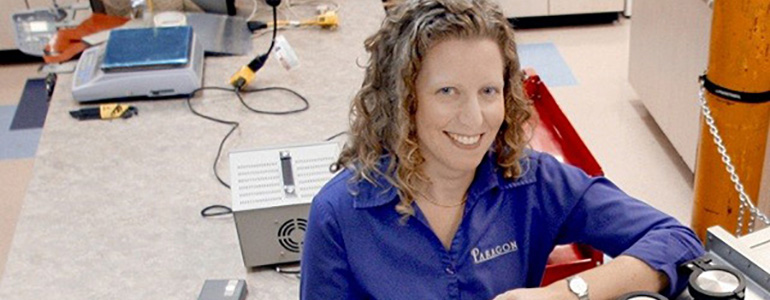“Whenever it came time for milestone reviews, we were able to satisfy all of the customer’s requirements.” – Stephanie Chiesi, senior systems engineer (Photo copyright 2012 Arizona Daily Star)
“We [humans] put out CO2 and moisture,” explained Grant Anderson, CEO of Paragon Space Development Corporation. “If you don’t take these out of the air in a spacecraft, water can condense, causing bacteria growth, shorting out equipment, or clogging critical airflow passages, and the CO2 can cause carbon dioxide poisoning.”
Needless to say, such events are unacceptable and are why consideration of a humidity control system in a spacecraft is highly critical.
Stephanie Chiesi, senior systems engineer, worked on the humidity control subassembly for Boeing’s Crew Space Transportation (CST)-100 spacecraft while she was at Paragon Space Development Corporation. The team that Chiesi was part of designed the humidity control subassembly system for NASA’s commercial crew program.
“Humidity control in a spacecraft is unlike the system for your house, because you have to take into consideration the closed loop environment of the vehicle, as well as the conditions the system needs to survive during launch and reentry,” Chiesi explained, “factors which aren’t part of the day to day concern for humidity control in a house on Earth.”
“That’s why Vitech’s CORE [systems engineering software tool] was so helpful as we designed the CST-100,” Chiesi said.
Producing such a unit involves a great degree of complexity. “There are a huge number of different requirements involved in the humidity control subassembly,” Anderson noted. “Humidity extraction rates, vibration, shock levels, International Space Station visiting requirements, etc. We have to show that we meet every one of them, so we use CORE to do that.”
With such complexity, it is important that changes in a model are reflected instantly and globally. “If we made a change in one place to the requirements or parameters that we were trying to verify, that change was instantly propagated in the other places it was referenced so that we didn’t have to remember all of the different documents where we had discussed that same element,” Chiesi said. “We had views that were all generated from the same source data. That allowed us to quickly generate the customer work products that were requested.”
The efficiency of using CORE showed up in other ways as well. The team used less manpower thanks to the tool. “There were many people contributing to the effort, but very few people were full-time on the whole project,” Chiesi said. Fewer people are required because CORE does the consistency and completeness checking for the user, ensuring that changes are consistent throughout the system. The user does not have to manually go through documents and models to make sure all changes are reflected.
Another benefit was the ease of satisfying the customer’s need for verification throughout project design. “Whenever it came time for milestone reviews, we were always able to show our latest and greatest status—satisfying all of the customer’s requirements and going through our detailed verification plans.” This is because CORE enables traceability between requirements, verification requirements, and test cases and events. The user always knows the current status of verification and what verification is being implemented for all of the requirements.
“The Boeing customer and NASA as well said that they had never seen a more complete and consistent verification strategy for that level of effort,” Chiesi noted. “They told us, ‘Wow. This is great. We can see everything. It’s very clear.’”
The requirements development and verification planning effort for the project was completed in a four-month period. “It was great that CORE enabled so much to be delivered in such a short span of time. We were able to tie in the traceability to all the analysis and design work that we were working on and planning for testing,” Chiesi said.
Another factor contributing to the timely completion of the project is CORE’s automatic generation of documents. “CORE’s automatic document generation features meant that we didn’t have to stop and write documentation—it was all generated directly from the source and able to be up-to-date whenever we needed it.”
All of these features, Chiesi said, meant that “the engineers better understood how their design and analysis work supported requirements.”
And astronauts on the CST-100 can now perform all their tasks on their way to the space station without having to worry about bacteria—or carbon dioxide poisoning.





